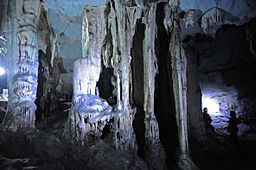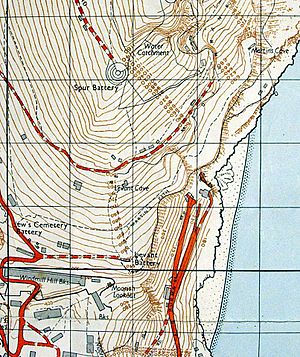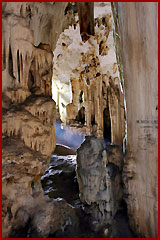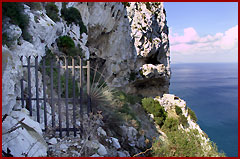Martin's Cave facts for kids
Quick facts for kids Martin's Cave |
|
|---|---|

Inside Martin's Cave
|
|
| Location | Eastern face of the Rock of Gibraltar, Gibraltar |
| Geology | Limestone |
| Entrances | 1 |
| Access | Mediterranean Steps |
Martin's Cave is a cool cave located in Gibraltar, a British territory. You can find it on the eastern side of the famous Rock of Gibraltar, not far from the top. Even though it's now high up, over 700 feet (about 213 meters) above the Mediterranean Sea, it used to be a sea cave long ago! It's only possible to reach this cave thanks to a special path called Martin's Path.
Contents
Martin's Cave: A Hidden Gem
Where is Martin's Cave?
Gibraltar is often called the "Hill of Caves" because it has so many! All these caves, including Martin's Cave, are made of limestone. They formed naturally over a very long time, even before humans arrived.
The caves were created when water slowly wore away cracks and openings in the rock. Martin's Cave stretches about 114 feet (35 meters) from its entrance. At its widest point, it measures about 73 feet (22 meters) across. The cave has only one way in and out.
How Was Martin's Cave Found?
The cave was discovered in 1821 by a soldier named Martin. That's how it got its name! One story says that Martin was exploring the top of the Rock of Gibraltar. He accidentally fell but landed safely on a narrow ledge right in front of the cave's entrance.
People worried he had fallen off the cliff. But three days later, he reappeared, looking a bit messy but safe! Back then, getting to the cave was very hard. So, the Royal Engineers built Martin's Path. This small path made it much easier and safer to reach the cave.
A visitor described the tricky journey a few years after the cave was found:
The path which we are obliged to traverse in order to get to it, is one of considerable difficulty and danger. We left our horses in charge of a servant half a mile from the cave, and proceeded along a narrow ledge, formed by art and with much labor, about three feet wide, until we reached the desired spot ... The south end and all the eastern side of Gibraltar is – or rather had been deemed, inaccessible, as it rises perpendicularly from the sea, and presents to the eye no ledges or asperities to encourage one to ascend or descent it, no matter what might be his inducement.
What Did Explorers Find?
In the 1860s, a man named Captain Frederick Brome wanted to explore Martin's Cave. He hoped to find old objects that would tell us about people who lived there long ago. The Governor of Gibraltar agreed, and a team of ten prisoners helped with the digging.
They started exploring Martin's Cave on June 23, 1868. They worked for about a month. They didn't find any signs that anyone had explored the cave in detail before. The oldest writing they found in the cave was from 1822.
Amazing Discoveries
During their dig, they found many interesting things! They discovered parts of a human jawbone. They also found many bones from animals like oxen, goats, sheep, and rabbits. There were even bird and fish bones.
Other finds included broken pottery pieces, some of which had cool designs. They also found 61 handles and pots. Tools like stone axes and flint knives were unearthed. They even found parts of armlets and anklets, which are types of jewelry. About 10 pounds of sea shells were also found.
One special find was a small, colorful, shiny copper plate. It seemed to have a design of a bird and a snake on it. They also found two swords, each over a meter long, that were from the 12th or 13th century.
Today, the British Museum has seven items that Captain Brome donated. Six of these items, including the two swords, a sword cover, two buckles, and a plaque, were all found in Martin's Cave.
Martin's Cave in World War II
During World War II, many of Gibraltar's caves were used by the military. Martin's Cave was used to hold large electric generators. Even though the generators are gone now, you can still see cables in the roof of the cave. These cables are a reminder of its industrial past. A nearby military battery was even named Martin's Battery.
Today, the cave gets a brief bit of natural sunlight right after the sun rises. To protect it from damage, the entrance to the cave is kept behind a locked gate. This gate is located off a nature trail called the Mediterranean Steps.
Bats in the Cave
Martin's Cave used to be home to many bats! In November 1966, a group called the Gibraltar Cave Research Group explored the cave. A painted sign on the cave wall mentions their visit.
Back in the 1960s, it was estimated that about 5,000 Schreibers' bats (Miniopterus schreibersii) and 1,000 large mouse-eared bats (Myotis myotis) lived there. However, a survey in 2002 found no bats in the cave. This might be because fireworks were sometimes used inside the cave, which would have scared the bats away.





